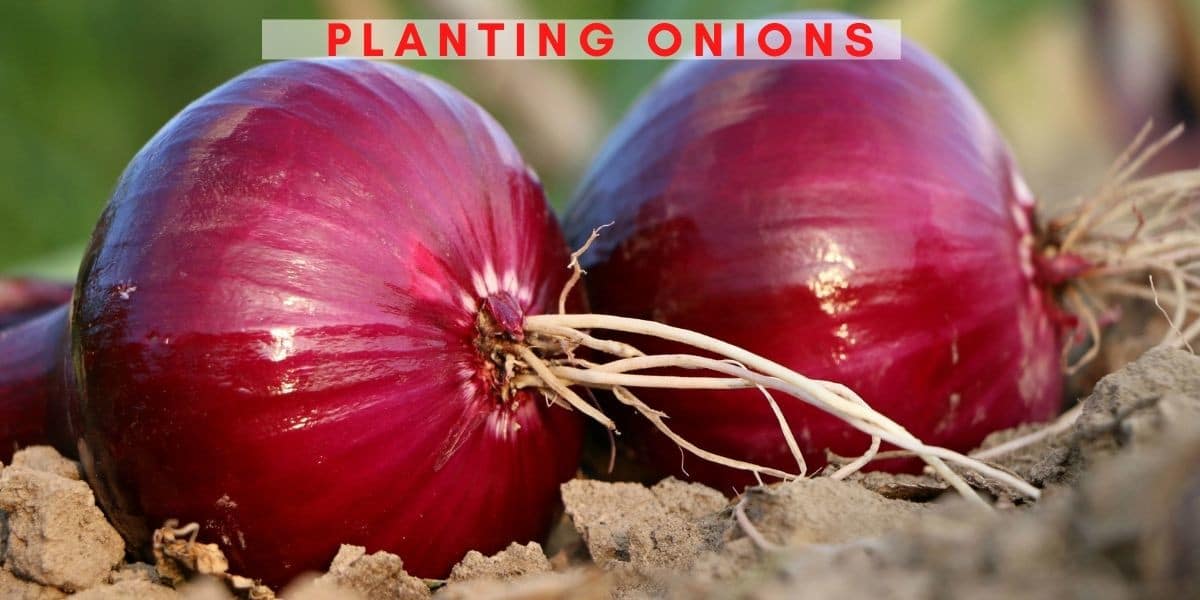Best Guide for Planting, Growing and Harvesting Onions
Planting Onions successfully then growing and harvesting is not easy for any farmer without knowing the proper way of cultivation.
Onions are a chilly season crop, simple to develop in view of their solidness. By midsummer, you can start collecting singular onions. Onions can be planted in either the spring or fall. Onion plants fill well in raised beds or raised columns something like 4 inches high. We generally plant a blend of white, yellow, and red onions.
In the nursery, onion plants ought to be dispersed 4 to 6 inches separated in the line, with lines 1 to 2 feet separated. Plant everyone around 1/2 inches somewhere down in a bit of opening. After planting, trim the tops to around 4 inches. Onions need about 1 inch of water each week, so if the climate is dry, you’ll need to water. Let’s come down and explore, how to plant, grow and harvest onions.
Table Of Contents
History Nutrition Planting Growing
Harvesting Variety Diseases Recipes
Overview Of Onions
Biological Name
Allium cepa
Plant Type
Vegetable
Maturity Period
80-150 Days
Maturity Size
6 inches tall
Soil Type
Rich, well-drained
Soil pH
Slightly acidic to neutral (6.0 to 7.0 )
Exposure
Full sun
Hardiness (USDA Zone)
5-10 (USDA); grown as an annual everywhere
Spacing
15 cm between rows and 10 cm between plants
Bloom Time
90 to 120 days
Toxicity
Toxic To Pets
Flower Color
red and yellow
Growth Rate
80- 150 days
Native Zone
Uncertain; perhaps central Asia
Maintenance
Onion being a shallow established harvest needs a regular light water system to keep up with ideal soil dampness for legitimate development and bulb improvement.
History Of Onion
Onions filled in Chinese nurseries as ahead of schedule as 5000 years prior, and they are probably the most seasoned Vedic works from India. In Egypt, You can follow onions from 3500 B.C. There is proof that the Sumerians were developing onions as ahead of schedule as 2500 B.C. One Sumerian content dated to around 2500 B.C. recounts somebody furrowing over the city lead representative’s onion fix.
Most analysts concur the onion has been developed for a very long time or more. Since onions filled wild in different areas, they were likely burned through for millennia and trained all the while from one side of the planet to the other.
Onions might be one of the soonest developed harvests since they were less transient than different food varieties of the time, were movable, were not difficult to develop, and could be filled in an assortment of soils and environments. Moreover, the onion was valuable for supporting human existence.
Onions forestalled thirst and one can dry and protect for later utilization when food may be scant. While the spot and season of the onion’s starting point is as yet a secret, many reports from early occasions depict its significance as a food and its utilization in workmanship, medication, and embalmment.
Nutritional Facts Of Onions
However all vegetables are significant for wellbeing, particular sorts offer novel advantages.
Onions are individuals from the Allium variety of blooming plants that additionally incorporate garlic, shallots, leeks, and chives.
These vegetables contain different nutrients, minerals, and strong plant intensities that have been displayed to advance well-being from various perspectives.
May Benefit Heart Health
Onions contain cancer prevention agents and mixtures that battle irritation, decline fatty oils, and diminish cholesterol levels — all of which might bring down coronary illness hazards.
Their strong mitigating properties may likewise assist with diminishing hypertension and secure against blood clusters.
Stacked With Antioxidants
Cancer prevention agents are intensifying that restrain oxidation, a cycle that prompts cell harm and adds to sicknesses like malignant growth, diabetes, and coronary illness.
Onions are a brilliant wellspring of cell reinforcements. Truth be told, they contain more than 25 distinct assortments of flavonoid cancer prevention agents.
Contain Cancer-Fighting Compounds
Eating vegetables of the Alliums variety like garlic and onions has been connected to a lower hazard of specific tumors, including stomach and colorectal.
An audit of 26 examinations showed that individuals who burned through the most elevated measure of allium vegetables were 22% more averse to being determined to have stomach malignancy than the individuals who devoured the least sum
Planting Onions
Best time for Planting Onions
- Onions (Allium cepa) are a concrete plant that can develop practically any season to the extent temperatures go.
- Most people plant them in late winter for a late-spring harvest or plant seeds in pre-fall or late-summer for an overwintered spring harvest.
- By a long shot, the main thing to realize while nailing the circumstance for onion planting is the day length for bulbing.
- To frame appropriate bulbs, onions need a specific number of long periods of sunshine in a developing season.
- This implies that regardless of whether your nursery remains a hot 80°F the entire winter, you will not have the option to develop bulbing onions in there except if you supplement with grow lights to arrive at the number of sunshine hours in summer.
Places of Planting Onions
In-ground plants and raised beds are both great alternatives for developing onions. Space onion plants are 6 inches separated in lines that are 12 inches separated. Develop them in a bright detect that has ripe, all around depleted soil with a pH of 6.0 to 6.8.
Planting Onions In Container
For developing planting onions in pots, select a holder dependent on the kind of Onion. For onions you intend to collect as scallions or green spring onions, an 8-inch (or bigger) pot turns out great. To raise bulb onions, you’ll need a holder wide enough with the goal that every Onion has around three crawls of room around it.
Planting Onions in Raised Beds
Onion sets are not difficult to plant in a raised bed. Basically, make a little opening in the dirt with your fingers, put the onion set into the opening, and cover the round with soil so just the actual tip of the onion set is noticeable on the dirt surface. The sharp finish of the bulb is highest and simply over the level of the dirt.
The best ideal opportunity to plant onion sets and raised beds is the finish of March. It’s a smart thought to water the onion sets in the wake of planting just to settle them in.
The lone serious issue in the wake of planting onions sets is birds. In certain spaces, birds love to peck out recently planted sets. The arrangement is to cover recently planted onion sets either with plant downy or some other netting.
Troubleshooting planting Onions
As an onion cultivator, there isn’t anything more befuddling than taking incredible consideration of your plants, possibly to get small or twisted onions when gather opportunity arrives around. This is perhaps the most disappointing encounter for home veggie landscapers. Fortunately, having information on a couple of fundamental onion realities could significantly affect your reap.
A portion of the top issues you might experience developing onions incorporate hindered development, stained leaves, withering or saggy plants, and deformed bulbs because of helpless soil, bothers, onion infections, or cold climate conditions.
Onion Growing Stages
Seeds, sets, and transfers. Onions can be developed from seeds, sets (youthful, tiny lethargic bulbs developed the earlier year), or transfers. Developing onions from seed can take as much as five months.
- You will discover seeds for some assortments or cultivars of onions. Sets are more straightforward to plant than seeds or transfers.
- Sets develop in just two months and are less helpless to infection. However, cultivar choice is restricted for sets. (Keep away from onion sets with bulbs bigger than a dime–they are probably going to bolt).
- Transplants are little seedlings that resemble scallions. Transfers need around two months to arrive at development.
Pruning
Pruning while seedlings are youthful is better for root and bulb development. Removing the top green development powers a more significant amount of the plant’s energy into the root framework. Furthermore, the shaping bulb is simply above it (onions bulbs are the foundation of the leaf framework with roots developing from the foundation of the bulb). Managing seedlings brings about plants with more life, more root improvement, and in the long run, in more giant bulbs—bigger onions!
Early pruning will likewise convert into thicker and more grounded greens that are more fit to live in the nursery and the varieties of wind and outside climate.
Bulb or grouping onions. Select bulb or grouping onions are relying on your proposed use. Bulb onions can go from little pearl onions to enormous Spanish sorts.
- Bulbs are white, yellow, or red at gather. Grouping onions–additionally called scallions or green onions–are developed for their delicate, green top stalks. They are reaped before the bulbs structure entirely.
How To Harvest Onion
On the off chance that the climate is dry and there’s no risk of ice, the plants can be delicately pulled from the dirt and laid right in the nursery for a little while. On the off chance that the climate is wet or ice is conceivable, move the onions quickly into a secured spot. The floor of the carport or a covered yard functions admirably. Spread the onions out in a solitary layer, taking into consideration not to knock or wound them. Leave them to spread out in a solitary layer.
Harvest Onion From Seeds
You’ll know it’s the ideal opportunity for collecting onion seeds when the umbrels or blossoming heads start becoming brown. Cautiously cut the stalks a couple of inches (8 cm.) underneath the head and spot them in a paper pack. Set the sack in an excellent, dry spot for half a month. When the charges are dry, shake them energetically inside the bag to deliver the seeds. Keep your seeds cool and dry through the colder time of year.
Variety of Onion
There are many types of Onion growing in different parts of the world. There are some-
- Sweet onions
- Bermuda Onions
- Chives
- Red onions
- Red Wing
- Leeks
- Sweet onions
- Vidalia Onions
- Welsh Onions
- Sweet onions
- Spanish Onions
- Pearl Onions AKA Button or Baby Onions
Pests And Diseases
Onion: Diseases and Symptoms
- Damping-off
- Purple smudge
- Twister sickness
- Fusarium basal decay/basal decay
- White decay (Sclerotial decay)
- Pink root decay
- Dark form
- Bacterial delicate decay
- Iris yellow spot infection
- Onion yellow bantam infection
- Wool mold
Recipes
- Grilled Onions
- Fried Onions
- Roasted Onions
FAQ
Can You Grow An Onion From An Onion?
How long do onions take to grow?
which is the best month for planting onions?
Are Onions hard to grow?
how do you know when to pick onions from the garden?
Does planting onions methods is a complex process?
Methods of planting selected are based on use, compatibility, cost, and planting ease. The most difficult part of planting onions is the growing of onions.

